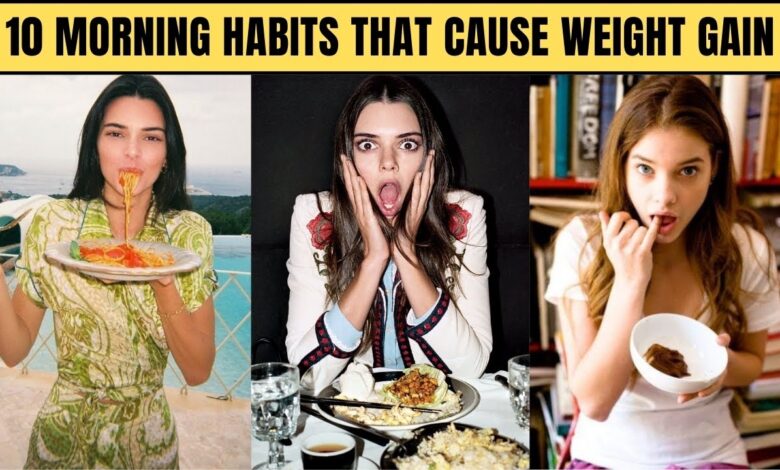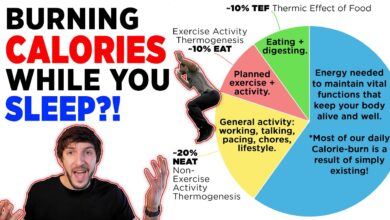
Very Common Yet Ignored Habits That Lead To Weight Gain
Very common yet ignored habits that lead to weight gain are surprisingly sneaky! We often overlook the little things that add up to significant weight fluctuations. From mindless snacking to stress eating and insufficient sleep, these seemingly small actions can derail even the most dedicated weight-loss efforts. This post dives into seven common culprits, revealing how they contribute to unwanted weight gain and offering practical strategies to break these habits and reclaim your health.
We’ll explore the science behind these habits, examining the hormonal responses and metabolic processes involved. But more importantly, we’ll provide actionable tips and easy-to-implement changes you can make today to start seeing results. Get ready to identify your personal weight-gain saboteurs and learn how to conquer them!
Mindless Snacking
Mindless snacking is a significant contributor to weight gain that often goes unnoticed. It’s the consumption of food without paying attention to hunger cues or the nutritional value of what we’re eating. This often happens out of habit, boredom, or emotional triggers, rather than genuine hunger. Understanding the patterns and implementing strategies to change them is crucial for weight management.
Common Scenarios of Mindless Snacking
Mindless snacking frequently occurs in situations where we’re distracted or not fully present. Common scenarios include watching television, working at a computer, driving, or attending social gatherings where food is readily available. The act of eating becomes secondary to the primary activity, leading to unconscious consumption of significant calories. For example, mindlessly munching on chips while engrossed in a movie can easily lead to consuming a whole bag without realizing the quantity eaten.
Similarly, stress eating often involves grabbing whatever is convenient, regardless of its nutritional value.
Healthy Alternatives to Unhealthy Snacks
Replacing unhealthy snacks with healthier options is a key strategy to combat mindless snacking. Instead of reaching for processed chips or candy, consider options that offer satiety and nutrients. For example, a handful of almonds or walnuts provides healthy fats and protein, keeping you feeling full longer than a bag of potato chips. Fruit, such as an apple or banana, offers natural sugars and fiber.
Greek yogurt is a good source of protein and calcium. Preparing these alternatives in advance and keeping them readily available can make healthy choices easier.
Strategies to Cultivate Mindful Eating Habits
Cultivating mindful eating involves paying attention to your body’s hunger and fullness cues. Before reaching for a snack, ask yourself if you’re truly hungry or if you’re eating out of boredom, stress, or habit. Slow down your eating pace, savor each bite, and pay attention to the taste, texture, and smell of your food. Eating in a calm and distraction-free environment, such as at a table instead of in front of the television, can significantly enhance mindful eating.
Practicing mindfulness through meditation or deep breathing exercises can also help improve awareness of your body’s signals.
Sample Weekly Meal Plan Minimizing Mindless Snacking
This sample meal plan focuses on balanced meals and healthy snacks to minimize mindless eating. Remember to adjust portion sizes to your individual needs and calorie goals. Monday:Breakfast: Oatmeal with berries and nutsLunch: Salad with grilled chicken or fishDinner: Baked salmon with roasted vegetables Tuesday:Breakfast: Greek yogurt with fruitLunch: Leftover salmon and vegetablesDinner: Chicken stir-fry with brown rice Wednesday:Breakfast: Scrambled eggs with whole-wheat toastLunch: Turkey and avocado sandwich on whole-wheat breadDinner: Lentil soup with whole-wheat bread Thursday:Breakfast: Smoothie with fruits, vegetables, and protein powderLunch: Leftover lentil soupDinner: Vegetarian chili with cornbread Friday:Breakfast: Whole-wheat pancakes with fruitLunch: Salad with chickpeas and feta cheeseDinner: Pizza with whole-wheat crust and plenty of vegetables Saturday:Breakfast: Eggs Benedict (using whole-wheat English muffins)Lunch: Leftover pizzaDinner: Steak with sweet potato fries Sunday:Breakfast: Waffles (whole-wheat) with berriesLunch: Chicken Caesar salad (using whole-wheat croutons)Dinner: Pasta with marinara sauce and vegetables
Calorie Comparison of Snacks
| Snack | Calories | Healthier Alternative | Calories |
|---|---|---|---|
| Potato Chips (1 oz) | 150 | Almonds (1 oz) | 164 |
| Candy Bar (1.5 oz) | 250 | Greek Yogurt (6 oz) | 150 |
| Soda (12 oz) | 150 | Water | 0 |
| Ice Cream (1/2 cup) | 200 | Fruit Salad (1 cup) | 80 |
Liquid Calories
We all know about the calories in the food we eat, but often overlook the significant contribution of beverages to our daily caloric intake. Sugary drinks, fruit juices, and alcoholic beverages are sneaky sources of empty calories, meaning they provide energy without essential nutrients, contributing significantly to weight gain if consumed regularly. Understanding the caloric content of our drinks is crucial for effective weight management.Liquid calories are easily consumed in large quantities without us fully registering their impact.
Unlike solid foods, which often require more chewing and time to consume, we can quickly gulp down hundreds of calories in a sugary soda or a cocktail. This rapid consumption makes it harder for our bodies to register satiety, leading to continued calorie intake even when we’re already full. This phenomenon makes liquid calories a significant factor in weight gain for many people.
Hidden Calories in Beverages
Sugary drinks, including sodas, sweetened teas, and energy drinks, are notorious for their high calorie content. A 12-ounce can of soda can contain anywhere from 140 to 160 calories, and many larger sizes contain significantly more. Fruit juices, while seemingly healthy, also pack a substantial caloric punch due to their natural sugars. A single 8-ounce glass of orange juice can contain around 110 calories.
Alcoholic beverages are another major culprit, with a single serving of many cocktails easily exceeding 200 calories. The high sugar content in many mixed drinks, coupled with the alcohol itself, contributes significantly to a high caloric density. Consider a margarita: the tequila, lime juice, and triple sec are combined with often a significant amount of simple syrup, adding up to a surprising number of calories per serving.
Tips for Reducing Liquid Calorie Consumption
Reducing liquid calorie intake is a straightforward yet impactful way to manage weight. Start by gradually replacing sugary drinks with healthier alternatives. Instead of soda, opt for water, sparkling water, or unsweetened tea. If you enjoy fruit juice, dilute it with water or choose smaller portions. When consuming alcoholic beverages, opt for lower-calorie options like light beer or wine, and be mindful of the mixers you use.
Pay attention to portion sizes, and consider keeping a beverage journal to track your daily liquid calorie intake. This awareness can be surprisingly effective in making mindful choices.
Caloric Comparison of Beverages
To illustrate the significant differences, let’s compare a few common beverages:
| Beverage | Serving Size | Approximate Calories |
|---|---|---|
| Cola (12 oz) | 12 ounces | 150 |
| Orange Juice (8 oz) | 8 ounces | 110 |
| Margarita (5 oz) | 5 ounces | 250 |
| Light Beer (12 oz) | 12 ounces | 100 |
| Water (12 oz) | 12 ounces | 0 |
Zero-Calorie and Low-Calorie Beverage Options
Numerous zero-calorie and low-calorie alternatives exist to satisfy your thirst without adding unnecessary calories.
- Water: The quintessential zero-calorie beverage.
- Unsweetened tea: A refreshing and flavorful option.
- Black coffee: Provides a caffeine boost without added sugar.
- Sparkling water: Offers a bubbly alternative to soda.
- Diluted fruit juice: Reduces the sugar content of fruit juice.
- Herbal infusions: Wide variety of flavors with no calories.
Calculating Daily Caloric Intake from Beverages
To calculate your daily caloric intake from beverages, simply add up the calories of each drink you consume throughout the day. For example, if you drink a 150-calorie soda, a 110-calorie orange juice, and a 100-calorie glass of wine, your total daily liquid calorie intake would be 360 calories. This is a significant amount, and keeping track of this helps you understand how much of your daily calorie allowance is being used solely from beverages.
Remember to consult nutrition labels or online resources for accurate calorie counts. Many apps and websites can assist with tracking and calculating caloric intake.
Remember: Even small changes in beverage choices can have a significant cumulative impact on your daily caloric intake and weight management goals.
Insufficient Sleep

Source: mayorboss.com
We all know sleep is important, but its impact on our weight might be underestimated. Insufficient sleep doesn’t just make us feel tired; it significantly contributes to weight gain through a complex interplay of hormonal imbalances and behavioral changes. Let’s delve into the science behind this often-overlooked factor in weight management.Sleep deprivation disrupts the delicate balance of hormones that regulate appetite and metabolism.
This hormonal disruption leads to increased hunger, cravings for unhealthy foods, and a decreased ability to burn calories efficiently. The result? Weight gain.
The Impact of Sleep on Appetite-Regulating Hormones
Research consistently demonstrates the link between sleep loss and hormonal shifts that promote weight gain. Studies have shown that insufficient sleep reduces levels of leptin, a hormone that signals satiety (fullness) to the brain. Simultaneously, it increases levels of ghrelin, the “hunger hormone,” which stimulates appetite. This hormonal imbalance creates a scenario where you feel hungrier and less satisfied after eating, leading to increased calorie consumption.
For example, a study published in theAmerican Journal of Clinical Nutrition* found that participants who slept only 4 hours a night had significantly lower leptin levels and higher ghrelin levels compared to those who slept 8 hours. This hormonal imbalance contributed to increased food intake and weight gain in the sleep-deprived group. Another study showed a correlation between short sleep duration and increased risk of obesity, particularly abdominal obesity.
Strategies for Improving Sleep Hygiene
Creating a conducive sleep environment and establishing healthy sleep habits are crucial for improving sleep quality. This involves optimizing your bedroom environment, managing stress, and regulating your sleep-wake cycle.
Establishing a Consistent Sleep Schedule
A consistent sleep schedule is paramount for regulating your body’s natural sleep-wake cycle, also known as your circadian rhythm. Here’s a step-by-step guide:
- Choose a bedtime and wake-up time that allows for 7-9 hours of sleep, and stick to it even on weekends.
- Create a relaxing bedtime routine, such as taking a warm bath, reading a book, or listening to calming music. Avoid screens at least an hour before bed.
- Make sure your bedroom is dark, quiet, and cool. Consider using blackout curtains, earplugs, or a white noise machine.
- Ensure your bed is comfortable and supportive.
- Expose yourself to sunlight in the morning to help regulate your circadian rhythm.
- Avoid large meals, caffeine, and alcohol close to bedtime.
- Get regular exercise, but avoid intense workouts close to bedtime.
Assessing Sleep Quality
Regularly assessing your sleep quality can help you identify areas for improvement. Use this checklist to evaluate your sleep:
- Do you fall asleep within 20 minutes of getting into bed?
- Do you wake up fewer than twice during the night?
- Do you wake up feeling refreshed and rested?
- Do you consistently get 7-9 hours of sleep per night?
- Do you experience daytime sleepiness?
- Do you have difficulty concentrating or remembering things?
- Do you have any underlying medical conditions that could be affecting your sleep?
Skipping Meals
We all lead busy lives, and sometimes skipping a meal seems like the easiest way to save time. However, this seemingly harmless habit can have significant, often overlooked, consequences for your weight and overall health. Regularly skipping meals, especially breakfast, can disrupt your body’s natural metabolic processes and ultimately contribute to weight gain, rather than the weight loss many people mistakenly believe it will achieve.Skipping meals throws your metabolism out of whack.
When you consistently deprive your body of fuel, it enters a state of energy conservation. Your metabolism slows down to compensate for the lack of incoming energy, making it more difficult to burn calories, even when you do eat. This metabolic slowdown can lead to increased fat storage and difficulty losing weight, even with dietary restrictions or increased exercise.
Metabolic Consequences of Skipping Meals
The body requires a consistent supply of energy to function optimally. When you skip meals, your blood sugar levels fluctuate dramatically. This can lead to feelings of fatigue, irritability, and difficulty concentrating. Furthermore, the body may start breaking down muscle mass for energy, a counterproductive effect if you are aiming for a healthy weight. Skipping breakfast, in particular, has been linked to increased cravings later in the day, often leading to overeating and poor food choices.
This cycle of deprivation and overconsumption is detrimental to weight management. The body responds to periods of starvation by slowing its metabolic rate and storing fat more efficiently, essentially preparing for future periods of food scarcity. This is a survival mechanism that works against weight loss goals.
Effects on Blood Sugar Levels and Energy Levels
Blood sugar regulation is crucial for sustained energy and overall health. When you skip meals, your blood sugar levels drop, leading to hypoglycemia. This can manifest as fatigue, dizziness, shakiness, and difficulty concentrating. The body then releases stress hormones like cortisol, which can further exacerbate the problem by increasing appetite and promoting fat storage, particularly around the abdominal area.
In contrast, regular meals help maintain stable blood sugar levels, providing consistent energy throughout the day and reducing cravings for sugary or high-fat foods. This stable energy supply helps prevent the energy crashes and subsequent overeating that often accompany skipped meals.
Incorporating Healthy Meals into a Busy Schedule, Very common yet ignored habits that lead to weight gain
Planning and preparation are key to incorporating healthy meals into a busy lifestyle. Meal prepping on the weekends can save significant time during the week. Preparing large batches of grains, proteins, and vegetables allows for quick and easy assembly of meals throughout the week. Another strategy is to utilize quick-cooking methods, such as stir-fries or salads, which can be prepared in minutes.
Additionally, keeping healthy snacks readily available can prevent impulsive, unhealthy choices when hunger strikes.
Examples of Quick and Nutritious Meals
Breakfast: Overnight oats (rolled oats soaked in milk or yogurt with fruit and nuts), Greek yogurt with berries, a smoothie with protein powder and fruits.Lunch: Large salad with grilled chicken or fish, leftover dinner, a whole-wheat wrap with hummus and vegetables.Dinner: Sheet pan dinners (vegetables and protein roasted on a single sheet), stir-fries with lean protein and plenty of vegetables, lentil soup.
Skipping Meals Versus Eating Regular, Balanced Meals
The difference between skipping meals and eating regular, balanced meals is significant. Regular, balanced meals provide consistent energy, stabilize blood sugar levels, support a healthy metabolism, and help maintain a healthy weight. Conversely, skipping meals leads to metabolic slowdown, blood sugar fluctuations, increased cravings, and ultimately, can contribute to weight gain. The consistent energy provided by regular meals also helps regulate appetite hormones, reducing the likelihood of overeating later in the day.
Stress Eating
Stress eating is a common, yet often overlooked, contributor to weight gain. It’s the act of turning to food as a coping mechanism for difficult emotions, anxieties, or stressful situations. While a small treat occasionally might not be harmful, habitual stress eating can lead to significant calorie intake and ultimately, weight gain. Understanding the triggers and developing healthy coping strategies is crucial for breaking this cycle.Common Stress Eating TriggersStress eating isn’t always about simply being hungry; it’s often a reaction to emotional or psychological triggers.
These triggers can vary widely from person to person, but some common examples include work deadlines, relationship problems, financial worries, and even seemingly minor daily frustrations. Recognizing these personal triggers is the first step towards managing stress eating.
Healthy Coping Mechanisms for Stress Management
Developing healthy coping mechanisms is essential for managing stress without resorting to food. These strategies help address the underlying cause of stress rather than masking it with temporary gratification from food. A multi-faceted approach is often the most effective.
Relaxation Techniques
Relaxation techniques, such as meditation and deep breathing exercises, can significantly reduce stress levels. Meditation involves focusing on a single point of attention, such as your breath, to quiet the mind and reduce racing thoughts. Deep breathing exercises, on the other hand, involve consciously slowing and deepening your breaths, which can activate the parasympathetic nervous system, promoting relaxation.
Regular practice of these techniques can train your mind and body to respond to stress more effectively. For example, practicing mindful breathing for just five minutes each morning can help set a calm tone for the day and improve resilience to stressful situations. Similarly, guided meditation apps offer various sessions tailored to stress reduction, sleep improvement, and emotional regulation.
Strategies for Managing Emotional Eating
Managing emotional eating involves identifying and addressing the emotional needs that are being met (or attempted to be met) through food. This requires self-awareness and a willingness to explore underlying emotions. Keeping a food journal can be incredibly helpful; recording what you eat, when you eat it, and how you’re feeling at the time can reveal patterns and triggers.
Developing alternative coping mechanisms for emotional distress, such as talking to a trusted friend or family member, engaging in a hobby, or journaling, can help break the cycle of emotional eating. Seeking professional help from a therapist or counselor can also provide valuable support and guidance.
Activities to Reduce Stress and Improve Well-being
Engaging in regular physical activity, such as exercise or sports, is a powerful stress reliever. Exercise releases endorphins, which have mood-boosting effects. Spending time in nature, practicing yoga, listening to calming music, pursuing hobbies, and ensuring sufficient sleep are also effective strategies. Prioritizing these activities can significantly improve overall well-being and reduce reliance on food for stress relief.
For instance, a 30-minute walk in a park can provide a welcome break from daily stressors, while engaging in a creative hobby like painting or knitting can offer a sense of accomplishment and relaxation. Adequate sleep is also crucial; lack of sleep exacerbates stress and can increase cravings for high-calorie foods.
Lack of Physical Activity
We all know exercise is good for us, but in the hustle and bustle of daily life, it’s often the first thing to get sacrificed. However, neglecting regular physical activity is a significant contributor to weight gain and overall poor health. It’s not just about burning calories; it’s about creating a healthier metabolic environment and improving your body’s ability to regulate weight.Regular exercise plays a crucial role in weight management by increasing your metabolism, boosting calorie expenditure, and improving your body’s sensitivity to insulin.
A higher metabolism means your body burns more calories at rest, making it easier to maintain a healthy weight. Furthermore, exercise helps build muscle mass, which further increases your metabolic rate. Increased calorie expenditure through physical activity directly contributes to weight loss or maintenance. Finally, improved insulin sensitivity means your body uses glucose more efficiently, preventing fat storage.
The Benefits of Cardio and Strength Training
Cardiovascular exercise, or cardio, is essential for improving cardiovascular health, burning calories, and boosting endurance. Activities like running, swimming, cycling, and brisk walking elevate your heart rate, improving blood flow and burning a significant number of calories. Strength training, on the other hand, focuses on building muscle mass. This is vital because muscle tissue burns more calories at rest than fat tissue, leading to a higher resting metabolic rate.
So many of us unknowingly sabotage our weight loss goals with seemingly harmless habits – like mindless snacking or skipping meals. It’s easy to get caught up in these little things, much like how focusing on immediate concerns can overshadow long-term planning, as highlighted in the article about Karishma Mehta’s decision to freeze her eggs, karishma mehta gets her eggs frozen know risks associated with egg freezing.
Both situations require careful consideration of short-term actions and their long-term impact on our health and well-being, and often, it’s the small, seemingly insignificant choices that make the biggest difference.
Strength training also improves bone density and overall strength, reducing the risk of injuries. A balanced approach incorporating both cardio and strength training provides the most comprehensive benefits for weight management and overall well-being.
A Sample Weekly Exercise Plan for Beginners
This plan is designed for beginners and should be adjusted based on individual fitness levels. Remember to consult your doctor before starting any new exercise program.
This plan emphasizes gradual progression, allowing your body to adapt to the increased physical demands. It balances cardio and strength training for optimal results.
| Day | Activity | Duration | Intensity |
|---|---|---|---|
| Monday | Brisk Walking | 30 minutes | Moderate |
| Tuesday | Strength Training (Bodyweight exercises) | 30 minutes | Beginner |
| Wednesday | Rest | – | – |
| Thursday | Brisk Walking | 30 minutes | Moderate |
| Friday | Strength Training (Bodyweight exercises) | 30 minutes | Beginner |
| Saturday | Cycling or Swimming | 45 minutes | Moderate |
| Sunday | Rest or light activity (Yoga, stretching) | 30 minutes | Low |
Gradually Increasing Exercise Intensity and Duration
The key to long-term success with exercise is gradual progression. Don’t try to do too much too soon. Start with shorter durations and lower intensity, gradually increasing both as your fitness improves. For example, if you start with 30-minute walks, aim to increase the duration by 5 minutes every week or two. Similarly, you can increase the intensity by walking at a faster pace or incorporating hills into your route.
With strength training, you can gradually increase the weight or resistance you use, or add more repetitions or sets. Listen to your body and take rest days when needed. Progress should be comfortable and sustainable.
Fun and Engaging Physical Activities
Finding activities you enjoy is crucial for sticking to an exercise routine. Don’t force yourself to do something you hate. Explore different options until you find activities that you genuinely find fun and engaging.
Consider these diverse options to find what suits your preferences and lifestyle:
- Dancing (Zumba, hip-hop, ballroom)
- Team sports (basketball, soccer, volleyball)
- Hiking or nature walks
- Yoga or Pilates
- Martial arts (karate, taekwondo)
- Rock climbing or bouldering
- Swimming
- Gardening
Large Portion Sizes

Source: ytimg.com
We all know that eating too much can lead to weight gain, but the impact of consistently consuming oversized portions is often underestimated. It’s not just about occasional overindulgence; the cumulative effect of regularly exceeding recommended serving sizes significantly contributes to a positive energy balance, leading to excess weight. Our bodies are remarkably efficient at storing excess energy as fat, and consistently large portions provide a surplus far exceeding our daily energy needs.The relationship between portion size and weight gain is straightforward: more food equals more calories.
Consuming larger portions than your body requires results in a caloric surplus, which is stored as fat. This process is independent of the food’s nutritional value; a large portion of healthy food can still contribute to weight gain if it surpasses your daily caloric needs.
Controlling Portion Sizes
Understanding and managing portion sizes is crucial for weight management. Several strategies can help you control how much you eat. First, use smaller plates and bowls. This simple visual trick can make your meals appear more substantial, even if the quantity of food is less. Second, measure your food.
Use measuring cups and spoons, especially for dry ingredients like rice, pasta, and cereal. This allows for accurate portion control and helps you become more aware of your consumption. Third, eat slowly and mindfully. Pay attention to your body’s hunger and fullness cues. It takes time for your brain to register satiety, so eating slowly allows you to recognize when you’re full before overeating.
Finally, pre-portion your food. Prepare individual servings ahead of time, storing the rest for later. This eliminates the temptation to overserve yourself directly from larger containers.
Nutritional Value and Caloric Content of Different Portion Sizes
The caloric content of a food item is directly proportional to its size. For example, a single serving of pasta might contain around 200 calories, while a double serving would contain 400 calories. This difference is purely based on quantity; the nutritional value per serving (e.g., vitamins, minerals, fiber) remains relatively consistent unless you’re adding extra ingredients. Consider a serving of chicken breast: a 3-ounce serving provides approximately 150 calories and a good source of lean protein.
We all know about big things like overeating, but sneaky habits like mindless snacking while working or consistently choosing sugary drinks really add up. Understanding the nutritional needs specific to our gender is key; check out this article on are women and men receptive of different types of food and game changing superfoods for women to learn more.
Then, armed with that knowledge, we can better tackle those small, easily overlooked habits that sabotage our weight loss goals.
A 6-ounce serving would double the calories and protein, but it may still be too much for some individuals’ daily needs. This highlights the importance of understanding not only the nutritional value but also the caloric density of food and how portion size impacts both.
We often overlook the little things that pack on the pounds – mindless snacking, sugary drinks, and skipping meals. It’s easy to get caught up in these everyday habits, but did you know that similar unnoticed changes can affect long-term health? For example, research suggests that subtle changes in vision, as discussed in this fascinating article on whether can eye test detect dementia risk in older adults , could be indicators of larger health issues.
Understanding these subtle shifts, whether in our diet or our vision, is key to proactive health management, preventing weight gain and other potential problems down the road.
Visual Aids for Appropriate Portion Sizes
Visual aids can be incredibly helpful in understanding appropriate portion sizes. Imagine a fist-sized portion of cooked meat or poultry. This visual representation provides a readily understandable guideline. For grains, such as rice or pasta, a portion size could be visualized as roughly the size of your cupped hand. Fruits and vegetables can be estimated as a portion equivalent to the size of a baseball.
For dairy products, a serving of yogurt might be visualized as the size of a tennis ball. These are approximations, and individual needs may vary based on factors like activity level and metabolism, but these visual aids provide a helpful starting point for portion control. Remember that these are just visual guides; always check nutrition labels for more accurate information.
Final Conclusion
Taking control of your weight isn’t about drastic diets or grueling workouts; it’s about making sustainable lifestyle changes. By becoming more mindful of your eating habits, prioritizing sleep, managing stress effectively, and incorporating regular physical activity, you can achieve lasting weight management success. Remember, small changes add up to big results. So, identify the habits that are hindering your progress, implement the strategies discussed, and celebrate your journey towards a healthier, happier you!
FAQ Guide: Very Common Yet Ignored Habits That Lead To Weight Gain
What if I’m already struggling with a lot of these habits?
Don’t get discouraged! Start by focusing on changing just one habit at a time. Small, consistent changes are more effective than trying to overhaul everything at once. Celebrate your successes along the way to stay motivated.
How can I tell if I’m a stress eater?
Notice if you tend to reach for food when you’re feeling stressed, anxious, or upset. If you find yourself eating even when you’re not physically hungry, stress eating might be a factor. Try journaling your emotions and food intake to identify patterns.
Are all calories created equal?
No, the source of calories matters. 100 calories from a sugary soda will have a different impact on your body than 100 calories from a serving of fruits and vegetables. Focus on nutrient-dense foods that keep you feeling full and satisfied.




